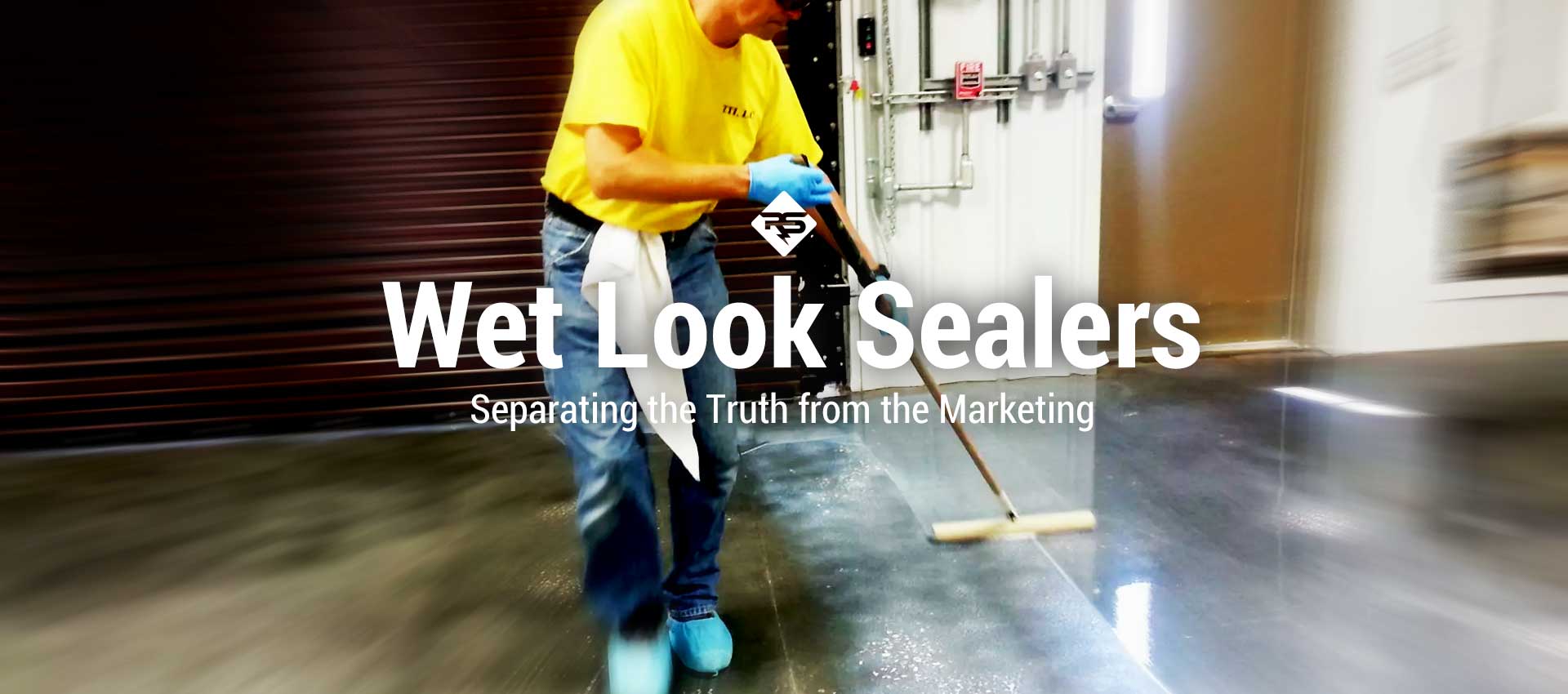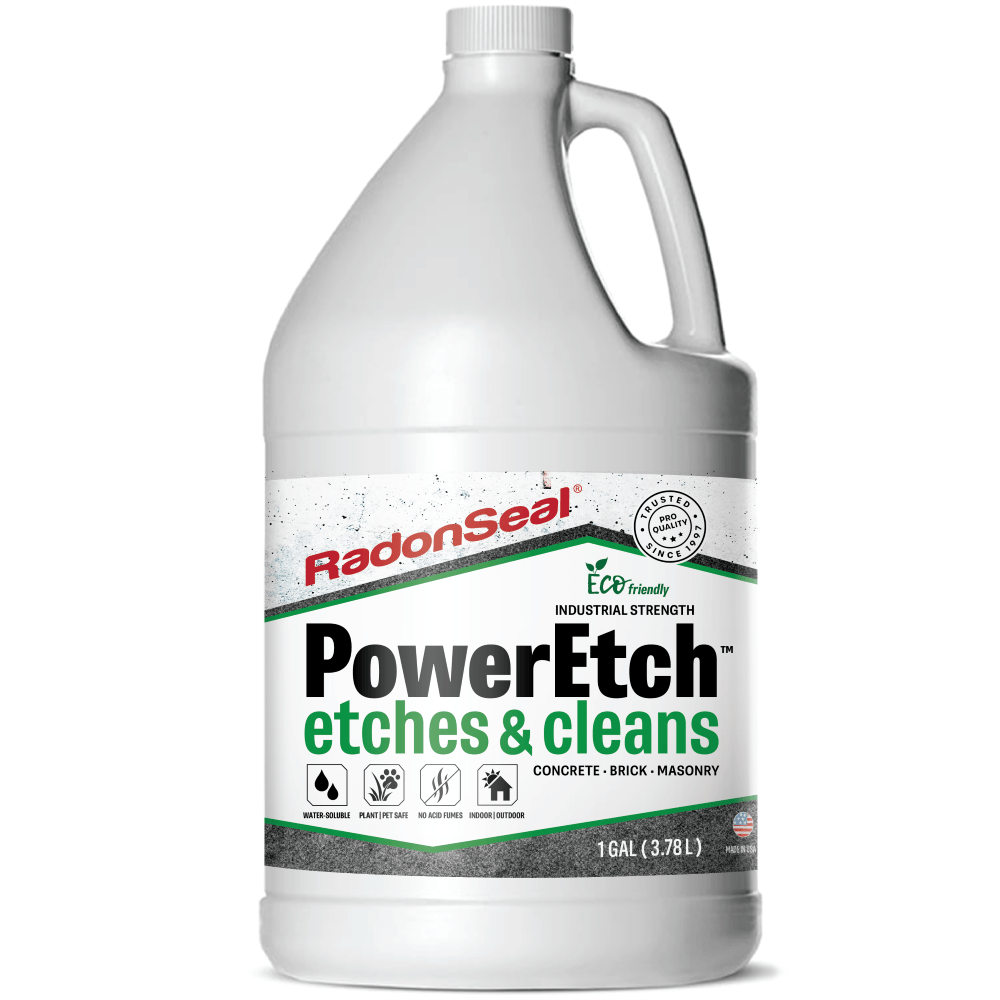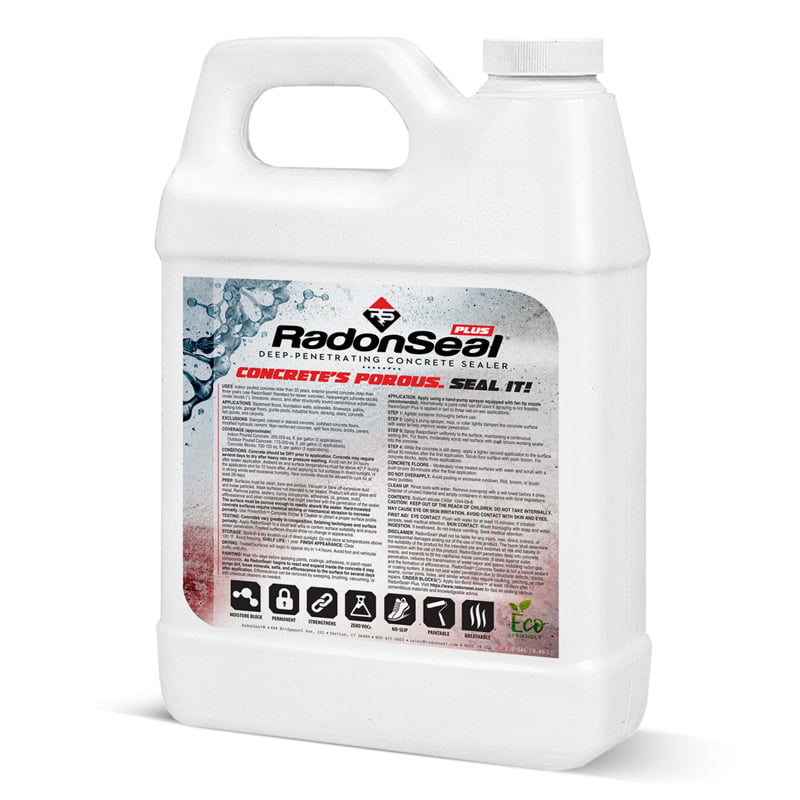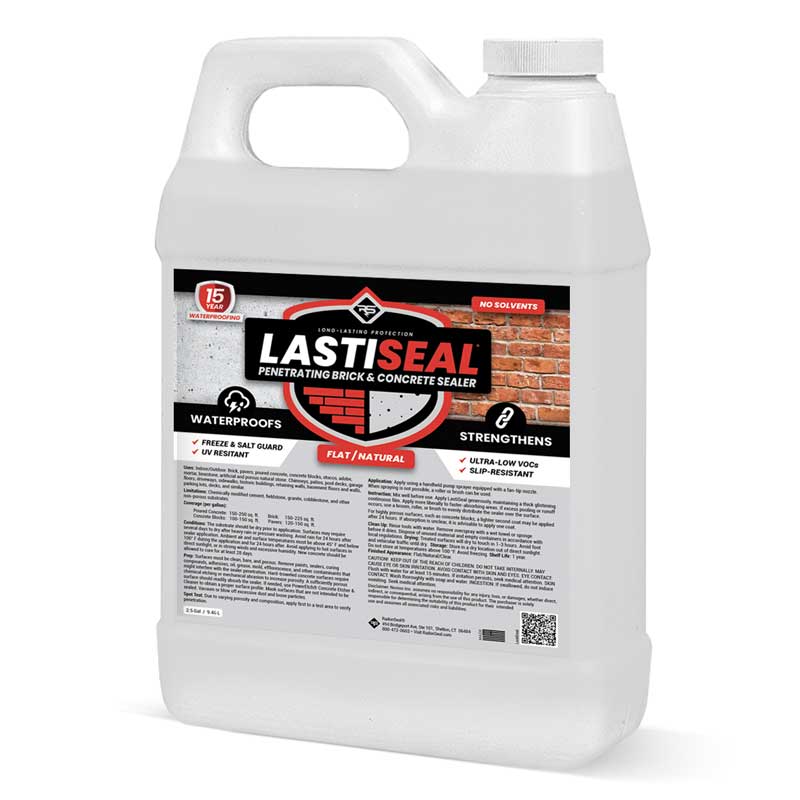Is a Wet Look Sealer Right for You?
Wet look sealers are a popular option found in most big box stores. A quick internet search will bring countless sites promising results and showing photos of picture-perfect hardscaping. It’s hard to deny the appeal of the shiny, reflective finish of a wet look concrete sealer, but the reality of these products can paint a very different picture. Let’s take a close look at wet look/glossy sealers, separate the truth from marketing, and explore your options when it comes to using these products.
What is a “Wet Look Concrete Sealer”?
A wet look sealer, as the name implies, is a concrete and masonry coating designed to make surfaces appear as though they are wet. Treated surfaces will have a slightly darker look, some color enhancement, and a glossy finish. Chemically speaking, wet look sealers are simply acrylic polymers in a carrier (water or solvent – more on that later). Once applied, the carrier dries, and the acrylic polymers left behind cure to form a thin (1-2 mils) surface film. Wet look sealers typically contain between 15-30% acrylic and are strictly a topical treatment. In other words, the acrylic is deposited only on top of the surfaces to which they are applied.
There is very little difference between the brands of wet look sealers you can choose from. You will find products advertising that their acrylic is shinier, more durable, or somehow better than their competitors. In truth, most wet look sealer manufacturers in the US buy their acrylic raw material from the same supplier. In fact, acrylic sealers have changed very little over the past 20 years and these claims are strictly marketing. Paying more for a wet look sealer because it is advertised as a “premium” product is not a good use of your money. The real difference between wet look sealers comes down to the carrier – water or solvent.
Water-Based vs Solvent-Based Wet Look Sealers
Water-based wet look sealers are inexpensive and very easy to use. Acrylic particles are suspended in a water carrier. They appear as a milky white liquid when applied. As the water evaporates, the acrylic polymers move close together and eventually fuse together. Because of their water base, they do not smell bad, are less toxic and flammable than their solvent-based counterparts and are suitable for both indoor and outdoor use. Most parts of the US as well as Canada have strict restrictions on the VOC content (volatile organic compounds) of concrete sealers. Water-based formulas all but eliminate VOC concerns making them universally accepted.
Solvent-Based Wet Look Sealers use solvents, typically xylene or some other hydrocarbon, as a carrier. The acrylic does not exist as suspended particles like they do in water-based sealers. Instead, the polymer and the solvent exist as one clear liquid solution. When the solvent evaporates, the polymers link together to form a shell. Solvent-based sealers tend to darken surfaces more than the water-based versions, but the difference is hardly noticeable on most surfaces. The most common solvent carriers used are xylene and acetone, which are both toxic, flammable, and likely to kill any vegetation (shrubs, grass, etc..) they encounter. This significantly complicates the application process and virtually eliminates indoor usage as a practical option. Solvent-based wet look sealers are more expensive than water-based products and are more expensive to ship to your door. Considering price, flammability hazards, potential toxic exposure, and heightened environmental regulation, in our opinion, it is hard to justify choosing solvent over water.
Health effects from direct exposure to VOCs can include eye, nose, and throat irritation, headaches and nausea, and liver, kidney, and central nervous system damage.
Sealer vs. Decorative Coating
Wet-look sealer (we use “sealer” loosely) is a bit of a misnomer. These types of products are better served by calling them “decorative coatings”. Their main purpose is to enhance the look of concrete and masonry. Their marginal ability to seal surfaces is simply a short-lived byproduct of the wet look finish. If a glossy, wet look is what you are after, then a wet look “decorative coating” is right for you. However, if you are interested in protecting and preserving your hardscaping, driveway, patio, or walkway, the quality of the seal is the priority, not aesthetics.
Wet Look Acrylic Sealer Durability
Acrylic coatings, when properly applied and cured, are about 1-2 mils thick…about as thick as a single human hair. You will find many wet look concrete and paver sealers advertised as “ideal for driveways”. This couldn’t be farther from the truth! Above all, a concrete or paver driveway sealer needs to be durable. The thin acrylic film doesn’t stand a chance in areas where vehicle traffic is routine. Homeowners tend to drive in and out of their driveways along the same path to their garage or parking spot. This causes premature sealer wear along that path. These areas will lose their wet look and turn dull or hazy and eventually, the acrylic will wear away completely, leaving an awkward, inconsistent finish to the driveway. Furthermore, heat from the tires will damage the coating when the car is parked on it. This is called “hot tire pickup” and it occurs when plasticizers in the tires bond to the acrylic coating. The tire then pulls the sealer/coating from the driveway when the car is moved.
Do you shovel your driveway, patio, or walkway in the winter? Well, say goodbye to your wet look coating. Shoveling will scratch the acrylic off the surface causing blemishes and compromising whatever protection it was providing.
How about using acrylic on your paver patio? Well, if you have patio furniture, then you may want to think again. Because the coating is so thin and the acrylic so soft, the simple act of dragging a chair across the patio can break through the thin acrylic, exposing the surface below to water and salts, and all the damage they can cause.
How Long Do Wet Look Concrete Sealers Last?
The decision to apply a wet look sealer to your concrete, brick, or pavers, is too often made without considering the long-term implications. The typical life expectancy of a wet look sealer is less than 18 months. Many retailers will claim 2 years or even 3 years, but this does not reflect real-world conditions. Longer service life claims refer to testing done in ideal conditions without exposure to vehicle and foot traffic, sun exposure, heavy rain, etc.
Even if the sealer is not damaged by traffic, shoveling or hot tire pickup, it will soon begin to dull, fade, whiten, and peel. This is because UV rays break down acrylic – the same way UV damages your skin. Sunlight causes microfractures and pitting that detract from the gloss and shine. Companies try and deceive you by claiming that their products are “UV resistant”. A leading wet look sealer supplier boldly proclaims that their product “can withstand 1,000 hours of UV exposure without fading!!!” In other words, their product can only tolerate roughly 90 days of sun before it begins to fade. Of course, once the sealer has faded the wet look is essentially gone. At this point, the sealer will need to be re-applied.
Common Problems with Wet Look Concrete Coatings
Scratching/Scuffing – The most common complaint associated with wet look sealers is that they lose their shiny wet look and become dull too soon. This can be caused by a variety of factors, the most common being foot or vehicular traffic. There is no easy fix for this problem and no way to prevent it. Wet look sealers are simply not appropriate for heavily used surfaces.
Dark Spots – Dark blotchy spots will develop when wet look sealers are applied too heavily. This can affect both water-based and solvent-based versions. This problem cannot be corrected. The sealer must be completely removed and reapplied. Most wet sealer manufacturers recommend 2 coats for optimal results but warn that too much will cause spotting. Applicators trying to produce a deep wet look often end up over-applying.
Roller Marks – An application error that is common in decorative coatings, including paint. Maintaining a wet edge is critical to avoiding this issue. Unfortunately, this can be very difficult when applied outdoors or in direct sunlight. Correction requires stripping and reapplication.
Blushing/Fogging – A very common problem associated with wet look sealers and a sign the coating has not properly adhered to the surface. Blushing is a precursor to failure and delamination. In other words, sealers that show signs of blushing will soon peel from the concrete. Blushing or whitening of the sealer is generally caused by water. If the slab is wet when the sealer is applied or the concrete has a high moisture content, the sealer will develop a foggy, hazy appearance. This can also be caused by applying the sealer to concrete that is too new. When this occurs, the sealer should be removed, and the slab should be allowed to properly cure before reapplication. However, when the treated slab lies on the ground, the source of moisture is groundwater seeping up through the concrete. Any reapplied wet gloss sealer will surely fog and blush again (the next time it rains or when the water table rises). Before applying the decorative wet look coating on concrete slabs lying on the ground, like foundation slabs, sidewalks, driveways, or pool decks, first deep seal the concrete with RadonSeal Deep-Penetrating Concrete Sealer to stop negative-side moisture transfer.
Peeling/Flaking – This is a failure of the wet look coating causing full delamination. It can be caused by several things – overapplication, reapplication without completely removing previous applications, or moisture, to name a few. It can also be a signal that the sealer has reached the end of its useful life. Additionally, if a wet look sealer is applied to a surface that is very smooth, it may not be able to bond properly. Proper preparation of the concrete surface is essential to success with any sealer. If your surface has been smooth-troweled, it should be first etched with PowerEtch Concrete Etcher and Cleaner. This will open the pores and significantly improve sealer bonding strength.
Bubbles – The presence of bubbles in the sealer surfaces is usually caused by the sealer being applied too heavily. Remember, a wet look sealer should be no more than 2 mils thick when cured (a sheet of paper is roughly 10 mils thick). Outgassing from the concrete surface should move easily through the wet sealer. When the sealer is too thick, air gets trapped in the sealer in the form of bubbles. Bubbles can also form when the sealer is applied in hot temperatures. In this case, the sealer will skin over before the water or solvent can evaporate. Best to apply sealers in the cool part of the day.
The True Cost of Wet Look Sealers
While it is true that wet look sealers are relatively inexpensive, the real cost goes beyond the initial cost of materials. Yes, acrylic is easy to come by and water is cheap, and although solvent-based products do cost a little more it’s hardly prohibitive. However, when we dig a little bit deeper, the actual cost may be quite surprising. Let’s break it down: Coverages for both water and solvent-based options are at best, 250 sq.ft. per gallon. The cost for a wet look decorative coating is between $45.00 and $70.00 per gallon. This works out to $0.18 and $0.28 per square foot. While that may seem like a good deal, if you read carefully through the product application instructions, you will notice statements like “unsealed concrete may require a second application”, and “two coats are suggested for even coverage and appearance”. These hidden caveats essentially double the advertised cost of the product.
Now, let’s consider the reapplication factor. As already explained, you should plan on re-applying your wet-look sealer every year or two if you want to maintain a nice appearance and provide an acceptable level of protection. Reapplication requires removing the old wet look sealer before applying the new one. Stripping old sealer can require pressure washing, specialized cleaners, or a xylene rinse. Time and material costs associated with this process is significant whether you are doing it yourself or hiring someone to do it for you…keep in mind you may find yourself doing this EVERY YEAR!
The Sensible Alternative
If you are unsure that a wet look sealer is right for you, be aware that there are other alternatives. Consider a penetrating sealer. Penetrating sealers are extremely effective and specifically designed to preserve and protect all types of porous concrete and masonry. These are not decorative coatings disguised as sealers. Since they penetrate deep into the pores, several inches below the surface, they are hidden from UV rays and are not susceptible to surface wear. That is why deep-penetrating sealer like LastiSeal Brick & Masonry Sealer lasts 10 -15 times longer than topical wet look sealers while RadonSeal Concrete Sealer is permanent.
If you absolutely must have a wet look, we understand and we’ve got you covered. For Pavers, Stamped Concrete, or Colored Concrete: First seal the substrate with LastiSeal Brick & Concrete Sealer, then follow with a water-based, wet look sealer. The pavers will be protected and deep sealed for 15+ years while the wet look acrylic will bond chemically to the LastiSeal polymers, resulting in a stronger bond and better performance. For Concrete Slabs: First, seal the concrete with RadonSeal Deep-Penetrating Concrete Sealer, then apply the wet look sealer. RadonSeal will deep seal the substrate and eliminate moisture transfer to the wet look coating.



